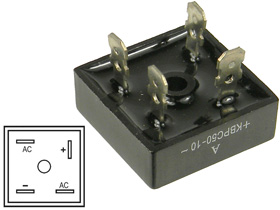Not being familiar with bridge number sequences, I use the 1N400x as an example. The higher the last number, the higher the voltage rating. I keep a couple dozen bridges around at any given time. For most applications, a 600 volt 40 amp bridge covers every thing I usually run into. 600 volts allow a diode to avoid any spuruous voltage spikes that may come from an inductive load such as a motor. I watch the various salvage vendors for cheap bridges at high voltage ratings and buy a half dozen or so at a time. It depends on shipping costs as a rule, I have seen (recently) such bridges go for less than a dollar each.
Usually, one corner is notched or keyed in some fashion. That will be the
positive(+) DC. The diaonally opposite terminal will be the
negative(-) DC terminal. The remaining two terminals are the
AC lines. If the AC lines are swapped, there will be no effect. If the DC lines are swapped, at best the motor will run backwards. At worst, electronics may be melted.
For a domestic appliance, a heat sink won't be required for a high current bridge. That's why I use 40 amp bridges almost universally. . . In the photo, there is a metal bracket that will serve as a heat sink. I often mount to a metal chassis that serves as such, although it really isn't necessary. There are bridges available for higher current, but today use 5/16 or 3/8 Fast-ons. The 1/4 lugs usually will fail if they are pushed to the higher current. If you are really paranoid, the bridge should have a solid contact and even joint compound. But it really isn't necessary. The big issue is to keep it from flopping around.
Diodes have a curious property (Fermi level) that the voltage drop is consistant across their voltage range. For most silicon diodes in the commercial market, that drop is 0.7 volts. Which in a domestic (120 V) appliance will be irrelevent. So long as the voltage rating (PIV) and current are not exceded, they simply don't matter. For something like a flashlight bulb, the Fermi drop must be considered, but that is waayyy outside this discussion.
My most common source is:
KBPC50-10 Bridge rectifier Rated 50A@1000VAC. .25 quick connect terminals.
www.mpja.com
where the identified item is about the maximun you will find. It is a little overkill, but hey. . . The 1/4 lugs won't stand up to a continuous 50 amps but will last almost forever at 25 amps. You will clear a breaker at 20 amps so is not an issue. Their shipping is a little high so I usually opt for a bulk buy.
.


